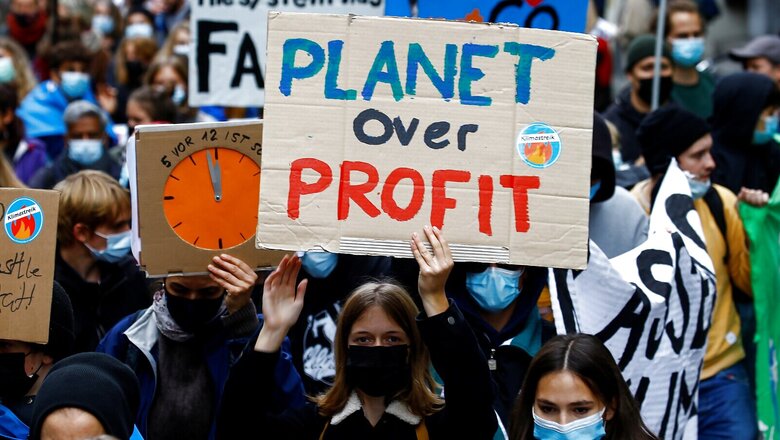
views
Limiting warming to 1.5°C will be out of reach if the world does not bring down global emissions by 48% by 2030 in comparison to 2019, warned the Intergovernmental Panel on Climate Change (IPCC) in the third instalment of its Sixth Assessment Report released late on Monday.
The United Nations body said the world is currently off-track and the likelihood of limiting warming to 1.5°C is now even lower than in 2018, because emissions continued to rise enormously. In fact, the emissions from fossil fuels rebounded to record highs in 2020 after a marginal fall during the pandemic, it said.
The report prepared by Working Group III makes it starkly clear the current Nationally Determined Contributions (NDCs) announced by countries are likely to exceed 1.5°C, and put the world on track towards 2.8°C warming by 2100.
“Even the most ambitious IPCC pathway of limiting warming to 1.5°C would still see temperature rise to temporarily peak at around 1.6°C by mid-century, before reducing to 1.3°C by 2100,” it stated.
The report, titled ‘Climate Change 2022: Mitigation of Climate Change’, was released late on Monday after two weeks of intense negotiations among the world’s top scientists and government representatives. It is also the first report of such magnitude to have been published since the Paris Agreement was approved in 2015, with perusal of over 18,000 scientific papers.
“It is a litany of broken climate promises. It is a file of shame cataloguing empty pledges,” said UN secretary-general António Guterres of the report, as he lambasted governments for “putting people firmly on track to an unliveable world”.
Mincing no words this time, Guterres further chastised governments and corporates “for choking the planet with historic investments in fossil fuels”, when cheaper, renewable solutions are available. The UN chief said there was urgent need to triple the speed of shift to renewables, and implored governments to stop funding of coal-fired plants, and move more investment and subsidies from fossil fuels to renewables.
In the same breath, he called upon climate coalitions of developed countries, financial institutions and corporates to support emerging countries in making this timely shift.
Glimmer of Hope: Revolution in the Renewables
The revolution in the renewables space emerged as perhaps the only good news in the otherwise grim picture of climate change, with prices falling faster and more dramatically than predicted. There has been a sustained decrease in the unit costs of solar energy (85%), wind energy (55%), and lithium-ion batteries (85%), and large increases in their deployment during the last decade.
This also augurs well for developing countries like India, who have been stepping up their renewable capacity to meet the energy requirements. According to IPCC, photovoltaics (PV), concentrated solar power (CSP) onshore and offshore wind, now all compete with fossil fuels on levelised costs of energy in many places.
The costs of electrified vehicles, including automobiles, two and three wheelers, and buses are all decreasing and their adoption is accelerating.
The report also bats for clean, electrified future, with electric vehicles offering the largest potential in climate mitigation.
“In a 1.5°C future, almost all electricity will be supplied by zero or low carbon sources by 2050. Electrification is especially crucial for enabling the de-carbonisation of road transport, industry, mining and manufacturing,” it said.
Fossil Fuels: Barriers of Change
Fossil fuels remain the biggest concern. The IPCC report issued a dire warning that existing fossil fuel infrastructure could single-handedly exhaust the remaining carbon budget, and any further installation of unabated fossil fuel infrastructure will ‘lock in’ emissions and put 1.5°C out of reach. Methane emissions need to reduce by a third by 2030.
It strongly batted for removal of fossil fuel subsidies, which models suggest can reduce emissions up to 10% by 2030, while improving public revenue and environmental and sustainable development benefits.
According to scientists, only when coal use is reduced by 100% by 2050, and oil and gas use are reduced by 60% and 70%, respectively, that the world can successfully limit warming to 1.5°C with no or limited overshoot. But this would mean leaving a substantial amount of fossil fuels unburned, and risks stranding large amounts of fossil fuel infrastructure, the combined discounted value of which has been projected to be $1- 4 trillion if the world limits warming to 2°C, and more for 1.5°C.
Substantial reduction in overall fossil fuel use across the full energy sector, the deployment of low-emissions energy sources, switching to alternative energy carriers, and energy efficiency and conservation is central to achieving climate goals. Use of alternate fuels for other sectors also offers potential.
Limited finance delaying mitigation
According to Professor Navroz K Dubash from Delhi-based public policy think tank, Centre for Policy Research (CPR), who was also one of the co-authors, the report pays far more explicit attention to equity and justice – internationally and domestically – than previous IPCC mitigation reports.
“The report recognises that equity remains a central element in UN climate negotiations, despite shifts in understanding of differentiated responsibilities of countries over time and challenges in assessing what is a fair contribution of different countries,” said Dubash.
The report highlights how countries that emit the least continue to be the most vulnerable to climate impacts. North America, Europe, Australia, Japan and New Zealand had 22% of the world’s population in 2019, but contributed 43% of historical cumulative CO2 emissions between 1850-2019. Africa and Southern Asia had 61% of the global population in 2019, but only contributed 11%.
Putting the onus back on developed countries, the report says that between 2020 and 2030, annual investments need to be three to six greater than current levels across all sectors to limit warming to 1.5°C. This comes at a time, when the developed countries are yet to even fulfil their commitment to provide $100 billion per year to climate fund.
The IPCC makes it abundantly clear that there is enough capital and liquidity to close the investment gap, and provide the necessary investment into the transition, with public and private finance flows for fossil fuels still greater than those for climate adaptation and mitigation.
“Accelerated financial support for developing countries from developed countries is a critical enabler to enhance mitigation and address inequities in access to finance, and economic vulnerability to climate change for developing countries,” it said, acknowledging that limited finance is a major reason for less adoption of low emission technologies in developing countries.
Reducing energy demand in urban cities
Simple lifestyle changes like walking and cycling can provide tremendous boost to climate action. Urban areas can significantly reduce emissions by reducing demand for all transport services and support the shift to more energy efficient transport modes and smart and shared mobility.
According to IPCC, the onus lies a lot on individuals with high socio-economic status who contribute disproportionately to emissions and have the highest potential for reducing their emissions.
The top 10% of households by per capita emissions (an indicator of wealth) contribute 34-45% of global consumption-based household GHG emissions, while those with per capita emissions in the bottom 50% contribute just 13-15%.
Carbon Dioxide Removal: Risky, but unavoidable
Clearing some air on the much-debatable issue of Carbon Dioxide removal (CDR), the IPCC said it has its limits and negative trade-offs, and must be deployed carefully.
According to the report, its deployment to counterbalance hard-to-abate residual emissions from agriculture, aviation, shipping, industrial processes is “unavoidable” if net zero CO2 or GHG emissions are to be achieved.
CDR basically refers to human activities that remove carbon dioxide from the atmosphere and store it durably in geological, terrestrial, ocean reservoirs or products.
According to report, agriculture, forestry and other land use contributed just over 22% of GHG emissions in 2019. Reducing deforestation, restoring natural ecosystems, improved and sustainable crop and livestock management, reducing food waste – all can be a crucial part of achieving net zero but it cannot compensate for delayed emissions reduction in other sectors.
Read all the Latest News India and Breaking News here

















Comments
0 comment